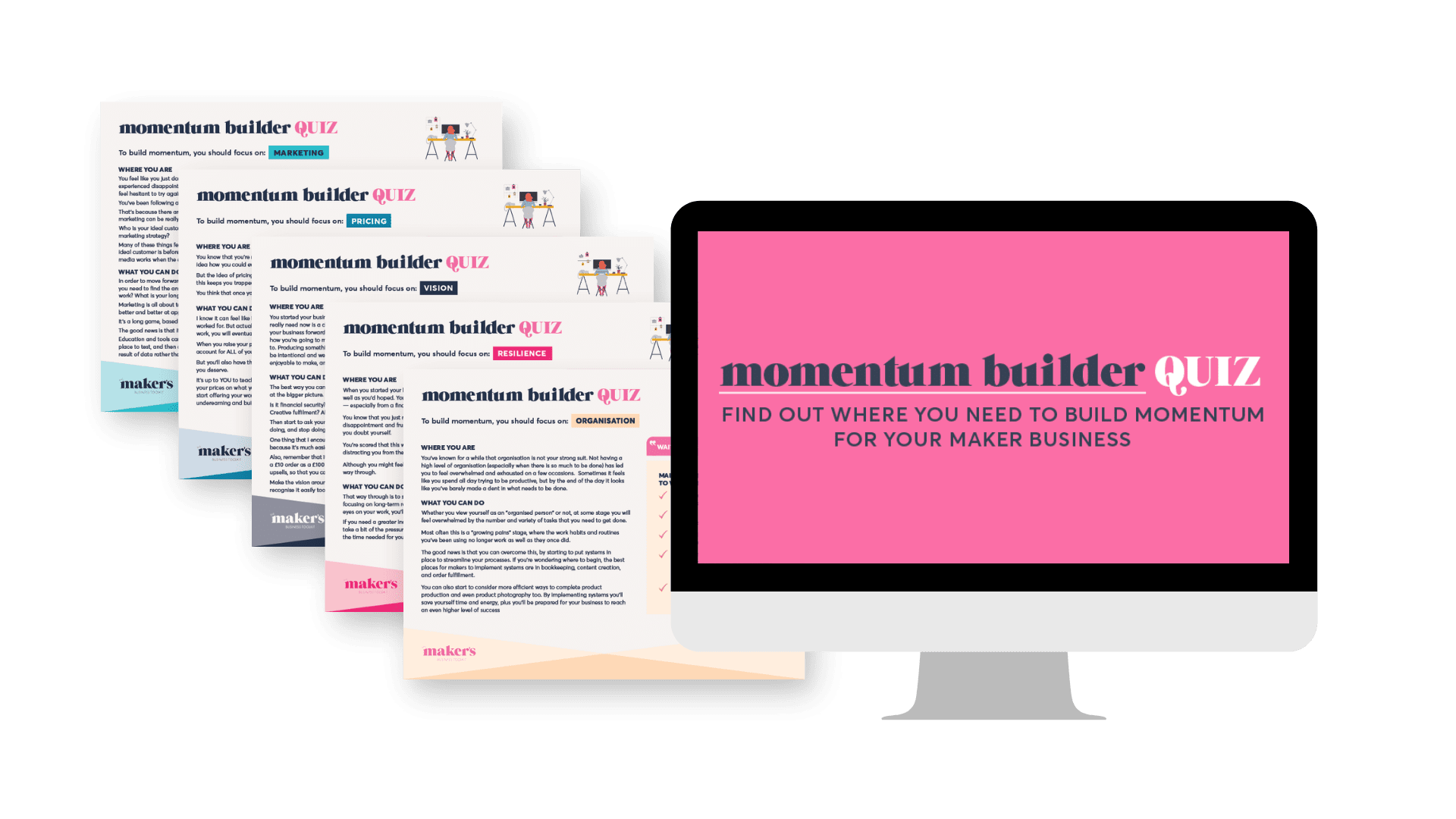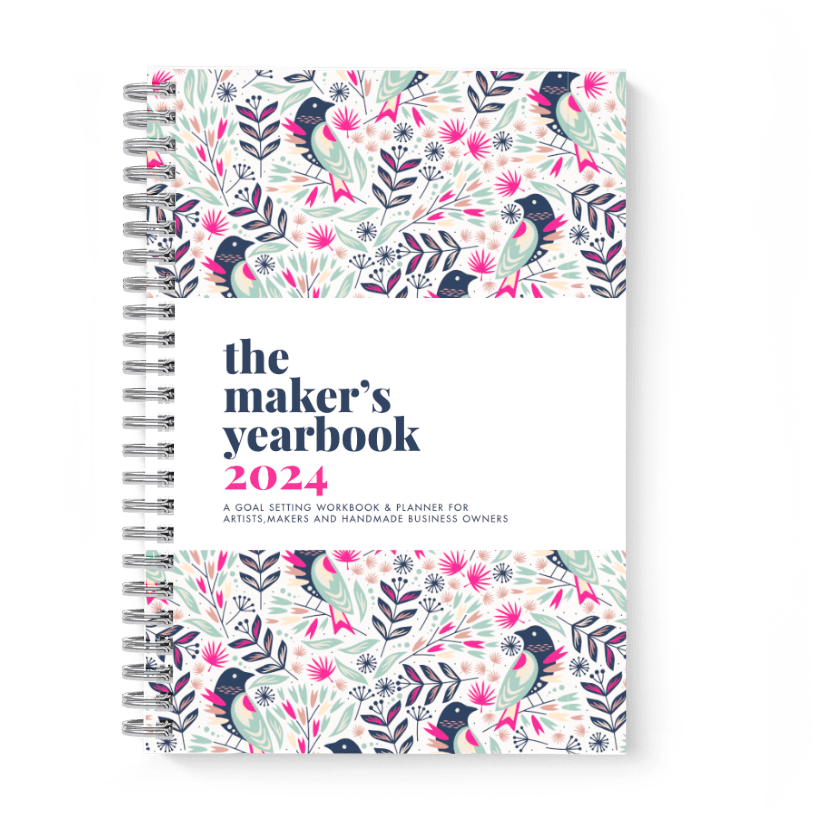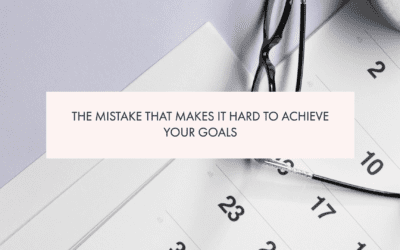Feeling completely overwhelmed and as if you can’t get anything done in your business?
Spending so little time making that you actually forget you’re a maker, rather than a professional email answerer?
As a solo business owner you can’t do it all.
I usually say that you have two choices: learn to do it, or hire someone else to do it.
But, what about when you do know how to do it, but you just don’t want to?
You have a different two choices: hire someone else to do it, or get a tool to make it quicker and easier for you to do it.
If you are freaked out by the idea of making your first hire, organisational tools can be a great compromise.
Here are the top five organisational tools that I simply could not run my business without:
Asana (task management)
Asana is a free project and task management tool. I use it to manage everything I have to do, but it is so much more than a simple to-do list.
I love that I can log in each morning and I know exactly what I have to do that day. No more wandering around the interwebs wondering what I should tackle first and then falling into a social media black hole.
HOW I USE IT
Every email I have to reply to gets posted into Asana as a task (I use Zapier to do this – another one of my must have tools) so that means I can stay out of my inbox during the day and limit distractions.
It also means I don’t have to use any of my brain remembering that I owe people a reply. I only have limited brain space and I need it all for doing my work.
I can also set it to remind me to do my accounts at the end of every month, schedule my social media once a week and write my email newsletter. Basically all of those things that you have every intention of doing regularly but always seem to forget about.
Asana looks after all of that for me and it’s so much harder to blow off the things you know you should be doing when it pops up in black and white on your screen.
I also use it to break down large projects into smaller tasks.
How often do you get overwhelmed by everything you have to do for a trade show or an exhibition or a new body of work?
How often do you put it off because it seems like so much to do and then fly into a desperate panic that makes you sick at the last minute?
Yeah, me too.
I honestly believe I could not have made it through the organization of my online photography course if I hadn’t had Asana. I would have got so overwhelmed that I probably would have decided it was “too hard” and given up. Or I would have paid loads for a tool that did everything for me and then made no profit.
As it was, I had a list of every task that needed to get done for the class to get off the ground and I just got on with it each day. No fuss, no stress, just consistent progress every day.
Asana Tip:
Create project templates for the processes that you complete repeatedly in your business.
I have them for setting up a new wholesale client, preparing for a craft fair, organizing a new exhibition, preparing for a speaking engagement and so many more.
Add in all the tasks you need to complete for that project and then next time you can simply copy the template and you’ve got a ready made to-do list, ready to go. You can also refine your project templates over time.
So if you decide that your new wholesale clients would benefit from an email after a couple of weeks, asking how everything is going, you can add this to your template and improve the process for the next time.
Zapier (Automation)
Have you ever wished that you could clone yourself or that there were more hours in the day?
Have you ever wished that all of the tools you use in your business were part of one big system that could handle everything? Your bookkeeping, your website, your email list, your inbox, your to do list.
Wouldn’t it be great if you didn’t have to keep reentering the same information?
Well Zapier makes that wish pretty much come true.
Sometimes it feels like you have all of these bits of software that work great on their own but don’t do much together. You have to add people manually to your email list or you have to enter your tasks into your to do list, or you have to do a lot of confusing and complicated tech twiddling to make everything work properly.
Zapier makes that a thing of the past.
You set up actions (called Zaps) that automate these processes.
So, you can set it up so that when you place an email into a folder called “Reply to” it automatically creates a task in Asana and adds the text of the email. Or you can use it to automatically add a line to a Google Spreadsheet every time someone places an order in your Shopify Store, to make doing your accounting much easier.
There are over 500 apps that work with Zapier and it is so simple to use. It is like having a personal assistant at a fraction of the cost and their support is amazing if you run into problems. I think you’ll find yourself completely addicted!
Zapier Tip:
Set up a Zap that adds a tag to your email subscribers every time they make a purchase in your Shopify store. I have one for each of my product lines: prints, greetings cards, jewellery, tote bags and device cases. This way you can tailor the content you send to the products they are most interested in.
Dext (Data Entry)
Dext was an absolute revelation to me when I first starting using it. I had tried other receipt scanning software before and never really found it was saving me much time but with Dext I saw the benefits immediately.
Dext extracts all of the data from your receipts and invoices and can then push the data directly to your accounting software (Xero in my case). No more data entry of receipts…..like EVER!!!!!
This was life changing for me. I get the majority of my receipts emailed to me and I can forward these emails directly to Dext where all the data entry is done. Then I literally just click a button and it all gets entered into my Xero accounts system and a copy of the receipt is stored in both Xero and Dext.
To make it even more “hands off” I even set up a rule in Gmail that automatically forwards all emails from my suppliers’ accounts departments to Dext and then files them away in a folder. Now I don’t see or touch any of them. It all happens automatically and works amazingly. MIND BLOWN!
You can also take a photograph of receipts using their handy app for IOS or Android and they’ll extract data from that too!
Dext saves me hours of time every month. Time I can spend making, or with friends and family, or binge watching The Walking Dead. Yay! They even send me a nice little weekly email that tells me exactly how much time they’ve saved me.
Dext Tip:
If you get receipts repeatedly from the same supplier you can set up supplier rules so that Dext always fills in the same information for the transaction description and payment method.
For example, I use Royal Mail online for all postage for my online store and I get hundreds of receipts from them. I set up supplier rules so that, when I submit a receipt from Royal Mail, Dext knows to label it “Postage to Customer,” set the payment method as “Paypal” and mark it as paid.
Dropbox (file management)
I love Dropbox because it makes it so easy to take all of my files with me when I’m away from my desk.
I used to get really stressed out about going to long craft fairs away from home because somebody would always need something while I was away and I had to tell them they would have to wait until I was back at my computer. For a chronic people pleaser like me this led to massive guilt and fretting about looking “unprofessional.”
It really sucks when a magazine you’ve been dying to be featured in calls you three hours after you have left for a four day show, with no access to your computer, and they want images and a bio.
Journalists are almost always working to a very short deadline and if you can’t get the information to them quickly, they can’t use you.
I missed out on a few opportunities I had worked really hard for this way, so I decided that it just couldn’t happen anymore.
Now I have virtually everything stored in Dropbox, rather than on my computer. My Mac runs a lot faster as a result and I can access everything while I’m on the go using the iPhone app.
I have folders for my bio and headshots, my product photographs, my terms and conditions, and stuff like proof of insurance and PAT testing. That way, I can get my fingers on anything I need very quickly. This came in handy recently when at a craft fair I was told that I hadn’t paid for electricity so wouldn’t be getting connected to the supply. I was able to quickly produce the receipt which showed I had indeed paid for electric and I got connected.
Dropbox tip:
Keep a “Press” folder containing everything a journalist might need if they contacted you. Headshots, various bios of different lengths, product shots etc. Keep these all updated and in a folder in your Dropbox and you’ll be able to respond quickly even if you’re sunning yourself in Lanzarote.
Convertkit (Email List Management)
I say Convertkit because that’s the mailing list service provider that I use, but you could use any mailing list provider that enables you to create email automation sequences. Automation is the secret sauce that allows you to really leverage the time spent on your email marketing.
Mailchimp and ActiveCampaign have this feature as well and I’m sure many other email providers do too.
When I started automating my email sequences, my business improved dramatically AND I spent much less time on email. So a win-win.
So what do I mean by email automation? Well, it’s the ability to send someone from your mailing list an automated sequence of emails that you have prewritten over a set period of time. You could do this for all sorts of reasons but one of the simplest to set up is an automation that will send your new subscribers a series of welcome emails.
Your prospects are most excited about you and your work at the moment they sign up for your email list. You can use this sequence to engage them even more, help them get to know you and hopefully encourage them to make a purchase from you.
You could also use email automation to send a follow up email to anyone who doesn’t complete their checkout in your Shopify store.
If you connect your Shopify store to Mailchimp, Shopify automatically passes this information to Mailchimp and you can use it to start an automation sequence that asks them if they need some help.
(You can accomplish something similar in other email marketing providers too, perhaps using Zapier to pass the information across.)
They might have changed their mind, or they might have experienced some difficulty with your store or the checkout process, or they might have found your shipping charges expensive. This kind of feedback is invaluable so you always want to ask for it. Even if you only get a response 5% of the time, that’s still more responses than you’d get if you didn’t ask.
Convertkit Tip:
Have an annual promotion you run? Maybe a Black Friday discount or a sale on your birthday? For me I have a launch of my calendar in the summer every year.
You can set up an automation sequence for that launch and save it ready to tweak and reuse the next year and the next year and the next year. Phew – time saved!
Canned Responses (Email)
Do you find yourself writing the same or similar emails over and over again? When people contact you to ask if you do commissions, or workshops, or if you speak to groups do you write out a response to each one individually?
If the answer is yes then you need to start using Canned Responses right away.
Canned Responses is a Gmail feature, but if you use another email service you can create templates in Google Docs to copy and paste or you can use a typing shortcut app like TextExpander to achieve the same result.
Create a “Canned Response” for each type of email you write on a regular basis. Maybe it is responding to people who contact you to ask about workshops. Or maybe it is a response to people who ask if you do commissions.
The obvious benefit of using these templates is that it saves you having to rewrite the same email, go looking for the information you need to give them about your workshops, or about your commission pricing structure. A less obvious, but really important benefit is that it takes the emotion out of saying no.
If you don’t do commissions and you don’t want to, you might feel uncomfortable or even guilty saying no. It’s draining to keep saying no and you may find yourself wondering if you should do commissions, or if you are missing out on another stream of income, or if you should give it a try “just this once.”
You might even find yourself ignoring people’s emails and just hoping that they get the message, which is definitely not a good way to run your business. An email template for responding to these emails takes the drama out of it and you don’t need to think about it…..because you’ve already thought about it.
Canned Responses can be as long or as short as you’d like and you can always personalise them before sending in order to respond to enquiries without sounding like a robot. The time and energy saved can be huge and you’ll also make sure that you don’t forget any important information.
Canned Responses Tip:
Be careful when inserting your Canned Responses into an email. For some reason, it has been designed so that the Delete option is the closest to your original cursor position and it’s easy to accidentally delete your canned response if you’re not careful. I have done this lots of times!
Automation is seriously cool. There is so much to do when you are a one person business and you can really shoot yourself in the foot by forgetting stuff or simply getting too overwhelmed to get it done.
These tools can help you. They’re not all free, but they are cheaper than hiring an assistant and they might just help you grow your business to the point where you can afford to pay someone to help you.
At the very least, they’ll give you a few more hours a week for doing something you love more than the accounts.
Honourable Mentions:
LastPass (Password Manager)
TextExpander (Typing Shortcut)
Later (Social Media Scheduling)
GoogleDocs (Word Processing and Spreadsheets)









